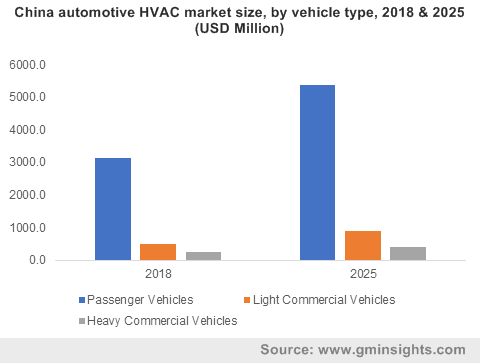An intrinsic outline of automotive HVAC market from a regional perspective: South Africa to emerge as the new contender on the block over 2019-2025
Publisher : Fractovia | Latest Update: 2019-04-05 | Published Date : 2016-10-27Request Sample
The robust increase in the number of customers demanding luxury features & comfort in their vehicles is fueling the growth of automotive HVAC market. The demand in fact, is so significant that HVAC systems are now being integrated into entry-level vehicle models as a standard option. The automotive HVAC systems are capable of monitoring & controlling the cabin temperature of the vehicle to maintain an optimum level of convenience & comfort for the passengers. The increasing demand for these systems can also be attributed to the evolving El Nino phenomenon, the abnormal warming of the equatorial Pacific Ocean, which would be further intensifying the already increasing global temperature.
China automotive HVAC market size, by vehicle type, 2018 & 2025 (USD Million)

Apart from the fairly conspicuous reason of rising global temperatures driving automotive HVAC industry, it is imperative to state that the phenomenon is also the primary factor that is warranting the need for vehicles to incorporate more advanced energy management & motor control systems to keep fuel consumption low and energy efficiency high to dampen the impact of vehicles on the environment. This ongoing trend will not only make vehicles friendlier to the environment but will also gradually propel the overall automotive HVAC market share.
Global automotive HVAC market | Impact of the Europe automobile industry
According to the International Council on Clean Transportation (ICCT), by 2016, vehicle sales in the European Union had completely recovered from the economic crisis that the region had experienced in previous years. in 2017, new vehicle registrations across the EU increased to about 15.2 million units, from the 14.6 million mark in 2016. Similar to previous years, the segment that showed the strongest growth was the sport utility vehicles (SUVs), which sold approximately 4.3 million units – a major factor that may have helped push the regional automotive HVAC industry trends.
While the automobile industry did recover significantly over the previous few years, the future growth prospects of the industry appear to be uncertain, due to the looming threat of the UK leaving the EU in a no-deal or hard Brexit, in the event of which the continent’s automobile industry would have to face an extremely volatile consequence. However, a recent assessment by the European Securities and Markets Authority found that overall automobile sales across the continent would remain stable during 2019.
The export of motor vehicles outside of the EU, which stood around 5.9 million units (worth €138.6 billion) in 2017, has been anticipated to be a major driving factor for the regional automotive HVAC industry. The fact that the United States is one of the largest importers of vehicles manufactured in Europe will also be responsible for the expansion of the Europe automotive HVAC market over 2019-2025.
Global automotive HVAC market | Impact of the rapidly expanding APAC automobile industry
Owing to the immense population and the rapidly improving economic conditions, APAC has established itself as the premier investment ground for the automotive industry contenders. The region is also home to some of the world’s top automobile markets – China, Japan and India, with the Chinese market being the largest, globally. Despite a proposed slowdown of the China automotive space, Japan and India are expected to pick up the slack, especially India, as the nation’s booming auto industry is slated to outgrow the Japanese automobile industry by 2021, claiming the 3rd spot globally behind the U.S & China.
According to the Asia Motor Business, in 2017 the automobile market of India grew at a faster rate than previously expected, fueled by falling interest rates as well as the nation’s rapid economic growth. This accelerated growth of the automotive industry coupled with the fact that the nation is among one of the hardest hit by the global rise in temperatures, would prove to be significantly conducive for the overall growth of the regional automotive HVAC market.
While APAC and Europe continue to vie with one another, the automotive HVAC industry has been the recipient of another contender – South Africa. On account of the expanding production of light commercial and passenger vehicles and the presence of American, Asian, and European companies in the region, such as Volkswagen, Nissan, BMW, Toyota, Ford, and Mercedes, South Africa has been making massive inroads in the overall automotive HVAC market. According to the NAAMSA (National Association of Automobile Manufacturers of South Africa), the region’s automotive sector procured remuneration worth more than USD 42 billion in 2017.
Powered by the steadily growing sales of automobiles worldwide, the global automotive HVAC market is slated to rake in significant growth over the forthcoming years. The projection is further supported by a Global Market Insights, Inc., research report that estimates the overall automotive HVAC market size to be surpassing the $25 billion renumeration mark by 2025.